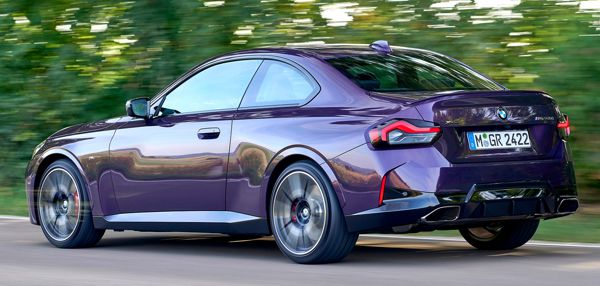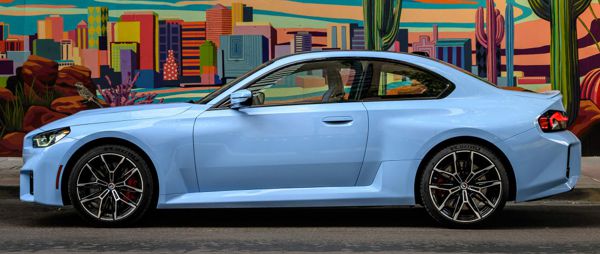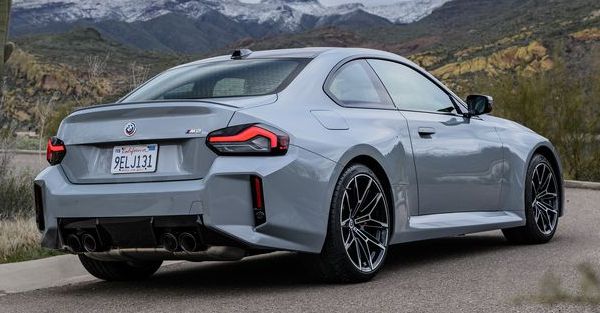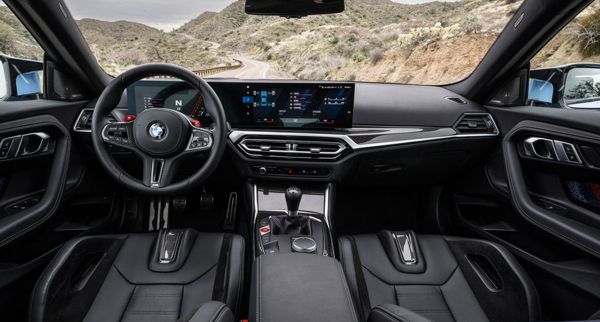Published
on 23
Dec 2021
|
All rights reserved.
|
|
|

|
|
Larger
and faster than ever, what separates it from the 4-Series?
|
|
You may trace the history
of BMW 2-Series Coupe all the way back to the days of 02-series, but
its direct predecessor should be 1-Series Coupe, introduced in 2007
mainly for the consumption of US market. BMW believed there was
sufficient demand for a compact 2-door coupe over there. To a certain
degree, it was right, otherwise the 1-Series Coupe would not have
evolved to 2-Series Coupe in 2014. However, rivals Audi and Mercedes
found even bigger success by selling their front-wheel-drive A3 saloon,
CLA-class and A-class saloon to the US market. The rear-drive 2-Series
Coupe just didn’t have the necessary cabin space and comfort to
respond. As a result, BMW greenlighted the development of 2-Series Gran
Coupe based on its front wheel-drive UKL2 compact car platform. Then
the next question is, what to do with the 2-Series Coupe? Turn to UKL2
platform and it could lose the dynamic edge over mainstream hot
hatches. Develop a bespoke rear-drive platform, as Toyota and Subaru
did with GR 86 and BRZ, and it might risk losing money, as the sales
potential for small coupes gets increasingly limited. In the end,
Munich decided to build the new 2-Series Coupe based on the CLAR
platform of 3 and 4-Series.
This sounds strange to me. Will it make the 2-Series Coupe too large,
too heavy and too expensive? If it is built on CLAR, then what
separates it from a 4-Series Coupe?

|
|
Larger
outside, smaller inside.
|
|
Even now, it is not easy to find the rationale behind this move. Yes,
the G42 generation 2-Series Coupe is really a lot bigger than the car
it replaces – 105mm longer, 64mm wider and 51mm longer in wheelbase. It
could have been bigger still if not BMW cut some space from the cabin.
Yes, the car gets larger outside but smaller inside, particularly for
rear passengers. Rear head room is reduced by 38mm, legroom is
shortened by 20mm while shoulder room suffers a setback of 43mm. Up
front, you feel the cabin wider, but leg and head room are virtually
unchanged. The addition of 2-Series Gran Coupe explains why BMW dare to
cut rear seat accommodation in the Coupe. In fact, the same strategy
has been applied to 4-Series Coupe already.
The arrival of 2-Series Gran Coupe also allows BMW to differentiate the
styling of the 2-door coupe, adopting a more aggressive design. It is
more angular, edgier and looks wider up front. A longer hood and
widened fenders, which accommodate 51mm wider front track and 31mm
wider rear track, make the passenger cell look smaller and the
proportion more cab-rearward. It is not exactly pretty, but certainly
more spectacular and more sportscar-like. Thankfully, it skips the
full-height double-kidney grille of the 4-Series and uses a wider,
horizontally oriented version like the one on Z4 roadster.
 |
|
M240i
xDrive is almost as quick as the outgoing M2 Competition.
|
|
The CLAR platform brings 12 percent increase of torsional rigidity, and
aluminum is used to construct its engine side members, spring struts,
bonnet and front fenders, but that doesn’t stop the car setting new
weight records. A rear-drive model is about 140kg heavier than its
predecessor, while range-topping (before M2 arrives in 2023) model
M240i is an astonishing 220kg heftier than the old model, blame partly
to the compulsory fitment of xDrive, M sport active differential and
8-speed automatic. And that’s before you opt for adaptive dampers and
variable ratio steering. At 1690kg, this "compact" coupe weighs more
than a 5-Series. And ridiculously, it is 20kg heavier than the M340i
xDrive with which it shares the entire powertrain, so what’s the point
of losing so much accommodation?
Benefited by the more powerful turbocharged straight-six, now offers
374hp instead of 340hp, the new M240i is good for 0-60 in 4.1 seconds,
0.3s quicker than before and trails the outgoing M2 Competition by
merely a tenth. The lesser 230i, powered by 258hp 2.0 turbo four, isn’t
so lucky, as its extra weight adds 0.2s, but 5.5 is still respectable
for the class. The base 220i and 220d are too slow to catch our
interest. All models are now automatic-only. Although ZF 8HP has always
been an excellent tranny, losing manual option is still a
disappointment to the BMW compact driver’s car.
 |
|
Roadholding
and stability much enhanced at the price of playfulness.
|
|
On the road, the M240i is impressively fast. Its smooth six-pot offers
excellent punch and low-down response, the automatic transmission
shifts quickly yet seamlessly. With near 50:50 weight distribution,
wheels pushed to the corners and an xDrive system that normally sends
all torque to the rear, the M240i feels well balanced and very stable.
It is not as agile or as playful as the old car though, because the
enhanced stability and massive grip afforded by wide rubbers make it
difficult to unstick the rear axle, not on a dry road. You will need a
wet surface or a track to find out that it is still capable to dance on
throttle. However, it is undoubtedly a far quicker car in the twisty,
thanks to its extra roadholding and stability. The responsive and
beautifully weighted steering, the firm but composed ride also help to
make the M240i feel like an M440i wrapped in a smaller package.
The 230i is far less serious, but its rear-drive chassis, lighter
weight and less grip actually allows you to play with its balance more
easily with the engine’s 295 lbft of torque. Moreover, it shares the
same high-quality interior with the M240i, which is actually
carbon-copy of those in its 3 and 4-Series cousins. You get the same
digital instrument and 10.3-inch touchscreen, head-up display and the
latest infotainment system. While the old 2-Series got a low-rent
interior to save cost, the new one feels just as high-quality and
sophisticated as its larger cousins. It also got a larger, 390-liter
boot, only 50 liters shy of the 4-Series.
Back to our question, what separates it from a 4-Series Coupe? Pricing.
In the US, 230i and M240i xDrive start at $37K and $50K, respectively,
a $10K cut over the equivalent models of 4-Series Coupe. You get
pretty much the same ingredients, and probably a slight edge in
dynamics. The 2-Series Coupe has always been great bargain, but this
time you should thank those buying the 3 and 4-Series subsidizing your
purchase.
|
Verdict:     |
Published
on 11
Jun 2023
|
All rights reserved.
|
|
M2 (G87)
|
|

|
|
New
baby M-car is virtually an M4 dressed in 2-Series body.
|
|
Modern BMW performance
cars get larger and larger, more luxurious and more luxurious. Today’s
M3 is equivalent to yesterday’s M5, making it too large, too heavy and
too expensive to many keen drivers. That’s why in 2011 Munich
introduced a new entry-level M-car called 1-Series M. It was compact,
quick and fun to drive, resurrecting the spirit of E30 M3. We loved it
very much, ditto its successor M2 and M2 Competition, but we also
noticed that it started migrating upmarket again, from the region of
£40,000 to £50,000 and even a whopping £75,000 for
the ultimate M2 CS. Admittedly, horsepower also grew from 340 to 370,
410 and 450 in the process, but isn’t it getting too close to the
territory of M3 and M4? When an entry-level M-car is no longer that
entry-level, what’s the point of its existence?
Unfortunately, with the launch of the G87 M2, this problem will get
only worse. Now the base M2 is a 460-horsepower machine that measures
half a class larger and weighs an astonishing 1725 kilograms – a gain
of 150 kg from the last M2 Competition. More worrying, its price starts
from £65,000, so you can expect the next Competition to be around
£80,000 and the CS could easily surpass £100K, no kidding.
That 1725 kilograms of kerb weight is for the car equipped with
standard automatic transmission. If you stick to manual, it will cut 25
kg, but you need to pay £1,345 for it, ridiculously, because BMW
sees very few people will opt for it. Either way, the M2’s kerb weight
is identical to the larger M4, another ridiculous thing.

|
|
Classic
coupe proportion is best viewed from the side.
|
|
Why is it so heavy? You know, the current 2-Series Coupe is already a
heavy machine. The M2 is rear-wheel drive only, unlike the lesser M240i
xDrive, but its performance hardware is transplanted straight from the
larger M3 and M4. This begins with the S58 twin-turbo 3-liter
straight-6 motor, which is mechanically the same as its senior
siblings. Only a reduction of turbo boost pressure to 1.2 bar scales
back its output to 460 horsepower and 406 pound-foot, compared with 510
hp and 479 lbft at 1.7 bar on M3 and M4 Competition. But that is
already 50 ponies more than the old M2 Competition. Likewise, it
employs the same ZF 8-speed automatic or 6-speed manual gearbox as the
M3 and M4, the same M active differential, the same brake package
(380mm discs with 6-piston calipers up front, 370mm discs and
single-pot at the rear), the same wheels and tires (275/35ZR19 front,
285/35ZR20 rear) which are probably oversized for the car. Even the
suspensions are carried over from the M4, sharing the same wider front
and rear tracks, stronger and lighter forged aluminum components. Ditto
the adaptive dampers, which is available to the baby M for the first
time. All these are packed into a relatively compact
body shell and then reinforced by additional bracings and shear panels.
A smaller car it might look like, its ingredients are solid and
sophisticated.
The new M2 is 121mm longer and 33mm wider than its predecessor. Its
wheelbase is stretched by 54mm, but undercuts the M4 by 110mm. We think
a shorter wheelbase is good for agility, though BMW counters that by
using a softer rear suspension setup to keep the tail planted.
Outside, its styling gives a mixed impression. While we love its
classic coupe proportion – a long engine compartment mates with a
well-defined cockpit section and a proper tail – plus the heavily
pronounced fenders that give the car a wheel-at-corner stance, we are
not a fan of its angular and frameless version of double-kidney grille,
or the square brake-cooling ducks that are mirrored at the rear bumper.
The elegance of early M3s is just not there.

|
|
Detuned
M4 engine produces 460hp, still more than the last M2 CS.
|
|
Enter the cabin, the first impression is a high-quality and classy
environment. There are carbon trims at many places, a superb steering
wheel on which a pair of customizable M-mode buttons are added and
cool-looking carbon-shell bucket seats – mind you, they are hard for
long journey, so better stick to the standard seats and save money. The
instrument is now housed in a big piece of curved display together with
the 14.9-inch touchscreen. Everything looks expensive, stylish and
state of the art,
unlike the early 1-Series M or the last gen M2 whose cabin looked as if
the source of cost-cutting. Now you think the extra
money is probably well spent. As usual, the driving position is good,
visibility too. You feel yourself wearing instead of riding on the car,
which is very important for a driver’s car. The rear seat is
predictably short of head and legroom, but it is obviously more usable
than those of a 911.
On the road, the M2 is seriously fast. The twin-turbo straight-six is
outstanding, delivering smooth and punchy performance. The exhaust note
is as melodic as usual. With 406 lbft of peak torque available from
2650 rpm to 5870 rpm, its power band is extremely wide, yet compared
with the even torquer M3/M4 Competition it feels more linear. You need
to squeeze harder and therefore having more fun in the process. BMW
claims 0-60 mph takes 3.9 seconds with automatic or a couple of tenths
more with manual, but it feels quicker still.
The ZF auto works flawlessly, making smooth yet precise shifts.
However, it is not quite as sharp as the old car’s DCT, dampening the
excitement a little. BMW’s 6-speed manual gearbox is not the best on
the market, with a longer throw and a less than slick shift quality,
but it is still more engaging than the auto.
 |
|
Still
a driver's car, but now more benign and less thrilling to push.
|
|
Predictably, given the longer wheelbase and a generation of progress,
the new M2 rides with more refinement. Sure, its suspension is stiff,
the ride feels taut even in the softest mode, but it is never crashy.
At lower speeds, small irregularities might trouble it, but as speed
rises, its damping improves markedly, and bigger bumps are settled
beautifully. There is less road noise penetrated into the cabin, too.
As a daily driver, the new car is definitely easier to live with.
Once slipping into the twisty, the M2 forgets about its weight, mostly.
It
controls its body movement tightly. Its meaty steering guides the nose
precisely into the corner. There is not a lot of feel from the
steering, but the weighting, speed and precision are beyond criticism.
Confidence also comes from the superb brakes and the tremendous grip
generated by those oversized Michelin Pilot Sport 4S rubbers – probably
even more than the old M2 CS with Cup 2 tires. The chassis balances
well, too. When it reaches cornering limit, it breaks away
progressively, never threatens to bite you.
Yes, the new M2 feels far more benign than the old M2 Competition. That
car always felt rawer and easier to oversteer. The new car can be
subjected to significantly more abuse. The combination of longer
wheelbase and softer rear springs means it prefers stability and
understeer when it approaches cornering limit. You need to push it
harder to expose its thrilling side, which is a shame. To committed
drivers, it is less entertaining to drive, even though it is
undoubtedly quicker.
As the M2 is just the first step of the evolution, that is probably
understandable. I am sure the next Competition will be tuned to steer
more aggressively. Whether it will expose the negative effect of extra
weight and size, we’ll see then. As for the M2, it is a remarkable
performance car, of course, but it is quite different to its
predecessors. Faster, more clinical and more luxurious but also
slightly
less engaging and less inspiring. Moreover, at £65,000 it is no
longer a performance bargain, because you can buy thoroughbred sports
cars like Cayman GTS, Corvette or Lotus Emira with similar money.
Still, we like it more than the larger M4.
|
Verdict:     |
|